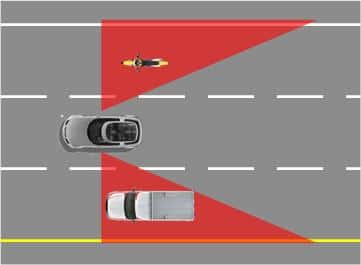This has probably come up before but do you think it is taught or necessary to look over your shoulder to check blindspot when changing lanes on the motorway?
I just need to add an edit. I’m specifically referring to looking over your shoulder on a motorway. Checking mirrors and blindspot is not under question
Not sure what your edit means. Looking over your shoulder is how you check your blind spots. So what exactly are you asking about if that’s “not under question”.
Thanks for asking the question. I was a passenger in a motorway accident where while the driver was performing an overtaking manouver was looking over thier shoulder and rear ended the car in front who suddenly broke. Isn’t your primary responsibility to make sure the road in front of you is clear? (The direction in which the vehicle is travelling. When reversing is it not more efficient to look over your shoulder than using your mirrors.
I agree with the unpopular comment made by https://lemm.ee/u/SwearingRobin (Sorry, don’t know how to properly link the comment)
I appreciate different situations require different behaviour but if you cannot maintain the 3 second rule so should your driving style be adapted?
I’m still not entirely sure what you’re asking, but you are responsible for BOTH the cars in front of you AND not changing lanes with someone in your blind spot. Both accidents would be your fault if you hit someone from behind OR changed lanes while someone is already occupying it.
If there’s not enough time to look over your shoulder before you would be too close to the person in front of you, then you should slow down to maintain a safe distance from the person in front of you, THEN check your blond spot over your shoulder, THEN change lanes and re-accelerate. It sounds like this person was too close to the person in front of them and/or approaching them at too high of a speed differential to safely check their blind spot over their shoulder AND return their head to forward facing before getting too close.
I see a lot of people here advocating for peeking over the shoulder, but to me that is insane. The only times I peek over my shoulder is if the car is not moving or going really slowly.
I’m not taking my eyes off the road for long enough to look over my shoulder. How fast are you guys moving your neck? A slight tweak of the steering wheel can veer you of course in the time it takes to look over your shoulder.
In the motorway I peek at the mirrors frequently to have a general awareness of the cars around me and where they are. If it’s day I have a general idea of the color and build of the most relevant cars to me, so I can know if a car is suddenly missing (probably in my blind spot), I should wait a bit for it come into my vision again (though the front or the mirrors)
When I decide to change lanes I look at all the mirrors and assess if it’s safe and if I’m aware of all the cars around me. Then I signal my lane change, wait a second, check the mirrors again, and start to change lanes gradually and predictably, to give any other driver that sees a dangerous situation plenty of time and space to react or signal to me in any way that the lane change is not safe.
To me this is the safest way to go about it. Newer cars have extra sensors to check the blind spot for you, which is great and gives you another degree of certainty, but I drove like this before I had a car that had this feature.
You are 100% responsible for where your vehicle is moving, that includes any blindspots. If you have a blindspot you MUST check it before moving into the space. So turn your head!
Sit in your car, physically, in real life. Have a friend take a bunch of traffic cones, or trash cans. Look forward, don’t move your head, using your mirrors only. Have your friend walk around your vehicle, putting down a cone when you can’t see them, and another cone when you can start to see them again… If there was any point where you couldn’t see your friend, that is a blind spot which you MUST check.

Yeah you always check your blindspots before changing lanes.
Yes, of course! Who would switch lane without looking, that is a setup for desaster. And it is definitely taught in driving school (at least in Austria, but I guess that is quite everywhere the case) to look in both mirrors and over the shoulder.
Yes, it’s both taught and necessary.
It may seem excessive when you’ve been checking the rear- and side mirrors for a long distance and you know that nobody is behind you… But it’s also in that exact situation that you’ll be surprised to see that some fucker has been cruising in your blind spot for a long time. Always check and don’t cruise in the overtake lane.
it’s also in that exact situation that you’ll be surprised to see that some fucker has been cruising in your blind spot for a long time.
An additional helpful tip is to get out of people’s blind spots. Don’t be the one driving in another person’s blind spot for an extended amount of time because they are a lot more likely to turn into you.
How can you tell when you’re in another driver’s blind spot?
It’s easier with more modern cars, because you can see the lights on a side mirror light up.
In general if you are less than a car length behind someone, until you can see them is not a great place to be.
I mean you can’t stay out of their “exact” blind spot, but vehicles aren’t that different. The blind spot is typically in the range of behind the driver’s side door to a few feet behind the rear bumper.
If you’re on their left, can you see their face in their side mirror. If you’re on their right, slow down or speed up so no part of your vehicle is along side theirs.
I was taught to do that, and I hope everyone does it, even if they think they’re the only car on the road. I’m a very safe but confident and decisive driver, and the number of times I’ve looked over my shoulder and been surprised by what I found is high enough that I will continue to always do it, even if it feels silly. It’s just not worth the risk.
Always. The cost of looking is null, while the cost of not looking can turn out to be someone’s life.
Checking my blind spot has saved me from driving into cars several times on the highway.
Yes it is.
I (as a US driver) was taught to follow this procedure when changing lanes:
- rear-view mirror
- side mirror
- peek over shoulder
Only then can you make the lane change.
It depends on your vehicle.
I personally drive a van, most of the time. Checking over my shoulder is a waste of time. What I do need is situational awareness. I’m aware of where my blind spots are, both absolute (e.g. directly behind my back bumper) and partial (e.g. the spot down my side).
I try and keep an awareness of everything entering and leaving my blind spots. I also do 2 checks of all spots that could have problems when manoeuvring. It’s alarming how often a small car or bike can slip through blind spots, when you’re doing your checks.
Basically, know your vehicle, and do what’s appropriate to keep everyone safe.
It depends greatly on the vehicle and how my mirrors are setup. I’ve driven far larger tractor trailer combos than most, dump trucks heavy equipment on a lowboy too. There are many instances when looking over my shoulder is just as pointless at looking at the floor.
Now, people that look at a phone for anything while driving, those are the fools that should be crucified. People that exit at the last second from the fast lane should be shot and buried too. If you have to look at a phone, use your car’s phone mode by forcing your transmission from D for drive to P for phone. It will solve all the phone driving problems. If you do not own the freeway, your primary responsibility is to everyone else on the road, and your ass comes last. You miss your exit, so the FnA what. Next time you’ll learn how to do it right, and we all get to have a next time.
do you think it is taught
It was taught when I went through driver’s ed class in the US.
necessary
Yes. There’s an area in most vehicles that you can’t see from your mirrors alone, and if you don’t check it, you can hit a car there.
https://en.wikipedia.org/wiki/Vehicle_blind_spot
As one is driving an automobile, blind spots are the areas of the road that cannot be seen while looking forward or through either the rear-view or side mirrors (expecting that the side mirrors are properly adjusted on a passenger auto – see above). The most common are the rear quarter blind spots, areas towards the rear of the vehicle on both sides.
Some vehicles aren’t capable of letting you check those areas over your shoulder; they typically have parabolic mirrors or something like that to let you see the area from the mirrors. But the normal case is that you need to check to be driving safely.
EDIT: Now that I think about it, I’ve always called curved mirrors on vehicles and mounted at blind corners “parabolic”, and my parents always have as well, which I think is where I got it…but thinking it over now, I bet that they aren’t actually parabolic. There’s no reason for them to specifically follow a parabolic curve that I can think of; they aren’t dealing with trying to produce parallel beams of light the direction that the mirror is facing. They need to be curved, but not specifically parabolic.
kagis
Yeah, this doesn’t say anything about it being parabolic:
https://trafficmirror.com/stainless-steel-highway-traffic-mirrors/
And ditto here for a vehicle mirror. Just says “convex”:
https://www.amazon.com/RETRAC-610901-Stainless-Center-Mount-J-Bracket/dp/B08HVPGQ99
No need. Your car sensors and AI rear camera/radar check for you.











